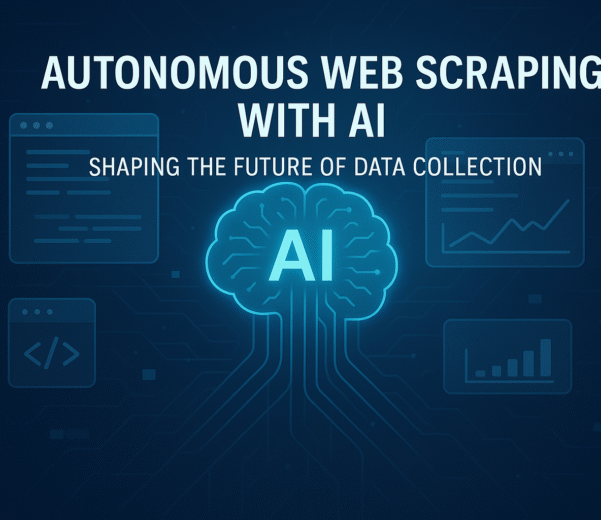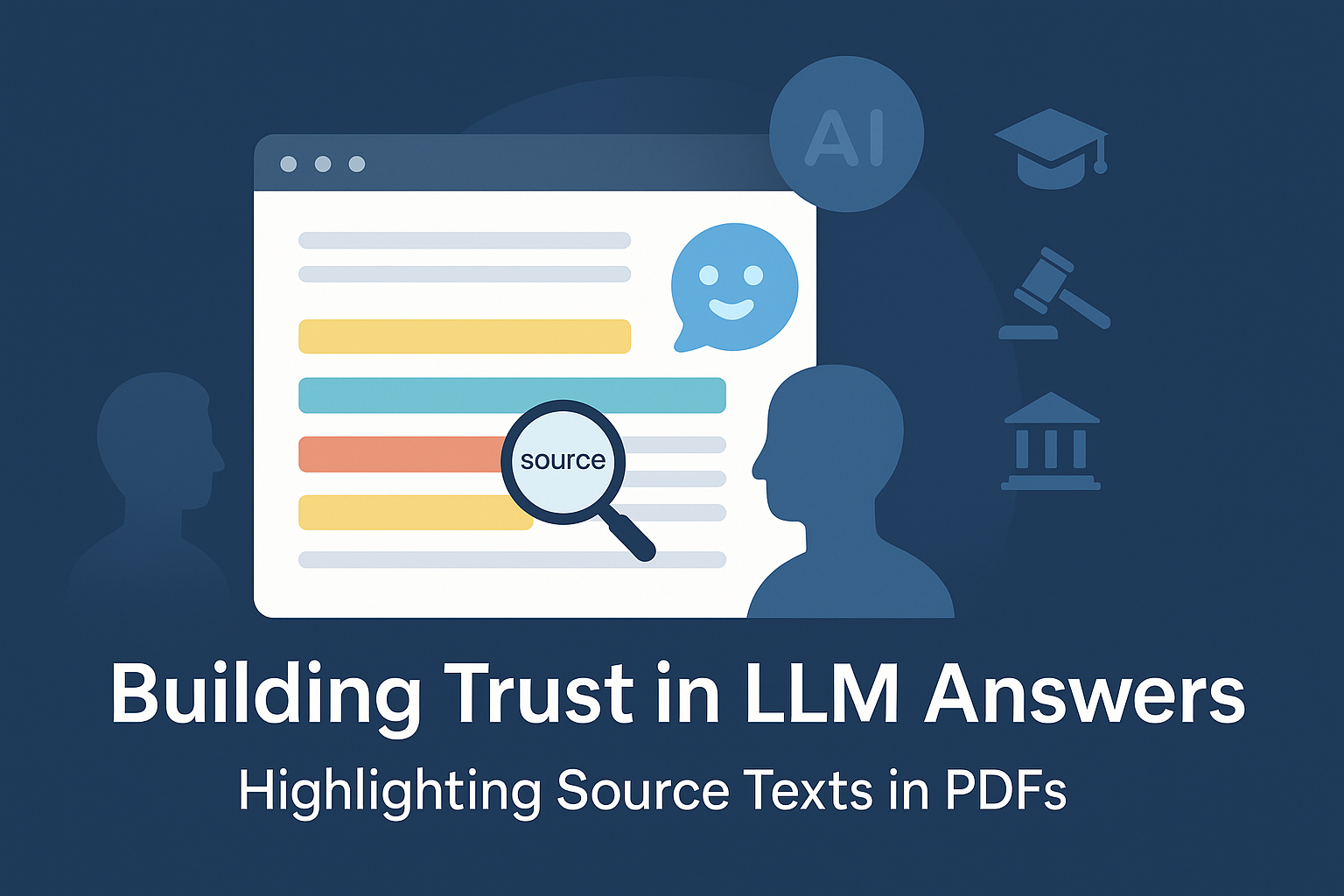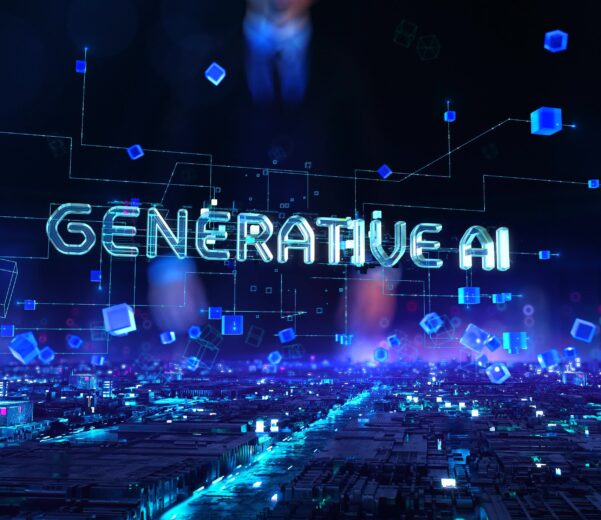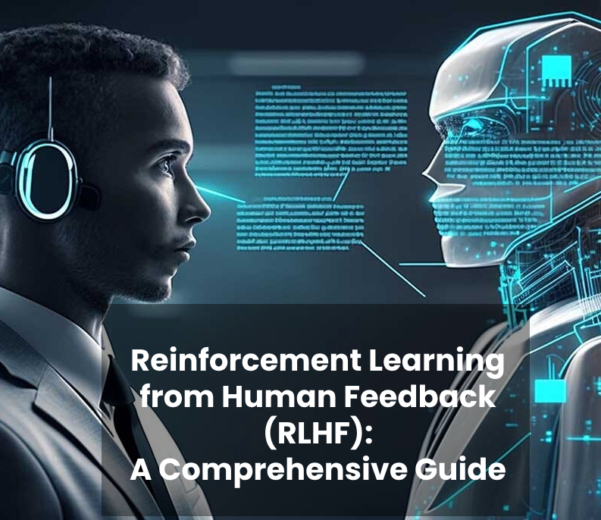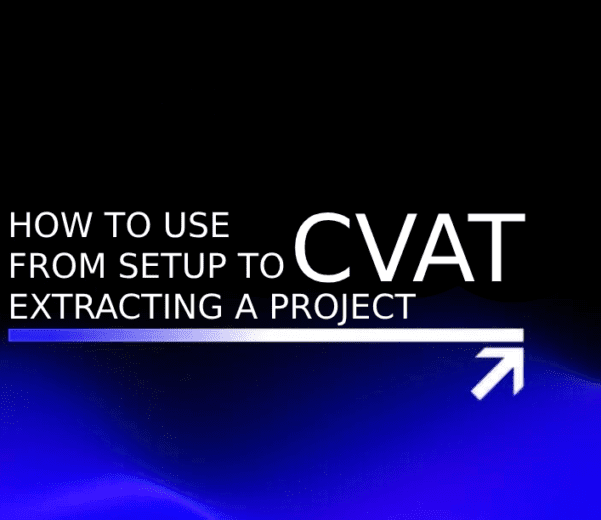Foundations of Trust in AI Responses
Introduction: Why Trust Matters in LLM Output
Large Language Models (LLMs) like GPT-4 and Claude have revolutionized how people access knowledge. From writing essays to answering technical questions, these models generate human-like answers at scale. However, one pressing challenge remains: Can we trust what they say?
Blind acceptance of LLM answers—especially in sensitive domains such as medicine, law, and academia—can have serious consequences. This is where source transparency becomes essential. When an LLM not only gives an answer but shows where it came from, users gain confidence and clarity.
This guide explores one key strategy: highlighting the specific source text within PDF documents that an LLM draws from when responding to a query. This approach bridges the gap between opaque generation and verifiable reasoning.

Challenges in Trustworthiness: Hallucinations and Opaqueness
Despite their capabilities, LLMs often:
Hallucinate facts (make up plausible-sounding but false information).
Provide no indication of how the answer was generated.
Lack verifiability, especially when trained on unknown or non-public data.
This makes trust-building a top priority for anyone deploying AI systems.
Some examples:
A student gets an incorrect citation for a journal article.
A lawyer receives an outdated clause from an older case document.
A doctor is shown an answer based on out-of-date medical literature.
Without visibility into why the model said what it said, these errors can be costly.
Importance of Transparent Source Attribution
To resolve this, researchers and engineers have focused on Retrieval-Augmented Generation (RAG). This technique enables a model to:
Retrieve relevant documents from a trusted dataset (e.g., a PDF knowledge base).
Generate answers based only on those documents.
Even better? When the retrieved documents are PDFs, the system can highlight the exact passage from which the answer is derived.
Benefits of this:
Builds trust with users (especially non-technical ones).
Makes LLMs suitable for regulated and audited industries.
Enables feedback loops and debugging for improvement.
Role of Source Highlighting in PDF Documents
Trust via Traceability: Matching Answers to Text
Imagine an AI system that gives an answer, then highlights the exact passage in a document where that answer came from—much like a student underlining evidence before submitting an essay. This act of traceability is a powerful signal of reliability.
a. What is Traceability in LLM Context?
Traceability means that each answer can be traced back to a specific source or document. In the case of PDFs, that means:
Identifying the PDF file used.
Pinpointing the page number and section.
Highlighting the relevant sentence or paragraph.
b. Cognitive and Legal Importance
Users perceive answers as more trustworthy if they can trace the logic. This aligns with:
Cognitive psychology: Humans value evidence-based responses.
Legal norms: In regulated domains, auditability is required.
Academic research: Citing your source is standard.
c. PDFs: A Primary Knowledge Medium
Many real-world sources are locked in PDFs:
Academic papers
Internal corporate documentation
Legal texts and precedents
Policy guidelines and compliance manuals
Therefore, the ability to retrieve from and annotate PDFs directly is vital.
Case for PDF Highlighting: Education, Legal, Research Use Cases
Source highlighting isn’t just a feature—it’s a necessity in high-stakes environments. Let’s explore why.
a. Use Case 1: Educational Environments
In educational tools powered by LLMs, students often ask for explanations, summaries, or answers based on course readings.
Scenario: A student uploads a 200-page political theory textbook and asks, “What does the author say about Machiavelli’s views on leadership?”
A reliable system would locate the mention of “Machiavelli,” extract the relevant paragraph, and highlight it—showing that the answer came from the student’s own reading material.
Bonus: The student can study the surrounding context.
b. Use Case 2: Legal and Compliance
Lawyers deal with thousands of pages of PDF court rulings and statutes. They need to:
Find precedents quickly
Quote laws with page and clause numbers
Ensure the interpretation is traceable to the actual document
LLM answers that highlight exact clauses or verdicts within legal PDFs support auditability, verification, and formal documentation.
c. Use Case 3: Scientific and Academic Research
When summarizing papers, students or researchers often need:
The key experimental results
The methodology section
The author’s conclusion
Highlighting helps distinguish between speculative interpretations and cited facts.
d. Use Case 4: Healthcare and Biomedical Literature
Physicians might query biomedical PDFs to ask:
“What dose of Drug X was tested in this study?”
Highlighting that sentence directly within the clinical trial report helps avoid misinterpretation and medical risk.
Common PDF Formats and Annotation Standards
Before implementing PDF highlighting, it’s important to understand the diversity and structure of PDF documents.
a. PDF Internals: Not Always Structured
PDFs aren’t designed like HTML. They are presentation-focused, not semantic. This leads to challenges such as:
Text may be embedded as individual positioned characters.
Lines, columns, or paragraphs may be disjoint.
Some PDFs are just scanned images (requiring OCR).
Thus, building trust in highlighted answers also means accurately extracting text and associating it with coordinates.
b. PDF Annotation Types
There are multiple ways to annotate or highlight content in a PDF:
| Annotation Type | Description | Support |
|---|---|---|
| Text Highlight | Traditional marker-style highlight | Broad support (Adobe, browsers) |
| Popup Notes | Comments associated with a selection | Useful for explanations |
| Underline/Strikeout | Additional markups | Less intuitive |
| Link | Clickable reference to internal or external sources | Useful for source linking |
c. Technical Standards: PDF 1.7, PDF/A
PDF 1.7: Supports annotations via
/Annotsarray.PDF/A: Archival format; restricts certain annotations.
A trustworthy system must consider:
Maintaining document integrity
Avoiding destructive edits
Using standardized highlights
d. Tooling for PDF Annotation
Popular libraries include:
PyMuPDF (fitz) – Excellent for coordinate-based highlights and text searches
pdfplumber – Best for structured text extraction
PDF.js – Web rendering and annotation (frontend)
Adobe PDF SDK – Enterprise-grade annotation tools
A robust system might:
Extract text + coordinates.
Find match spans based on semantic similarity.
Render highlight over text via annotation toolkits.
Benefits of In-Document Highlighting Over Separate Citations
You may wonder—why not just cite the page number?
While citations are helpful, highlighting inside the source document provides better context and trust:
| Method | Pros | Cons |
|---|---|---|
| Page Number | Easy to implement | User still has to scan page manually |
| Source Snippet | More helpful | Can be taken out of context |
| In-Document Highlighting | Context + direct evidence | Technically more complex |
It’s the difference between saying “Look at page 47” and showing:
“Here’s what was said—and here’s where it was said.”
In high-trust systems, this direct visual reference can even act as a legal proof or audit trail.
UX Patterns: How to Visually Present Highlighted Sources
Trust is not just a backend task—it’s a UI/UX mission.
a. Key Patterns
Hover to reveal source: Useful for compact UI.
Split view: Show answer on the left, PDF on the right.
Highlight and scroll: Click an answer phrase to scroll the PDF to the matching sentence.
Heatmap overlays: Use gradient coloring to show answer relevance.
b. Color Coding
Green: High-confidence match
Yellow: Partial/indirect evidence
Red: No exact match, just related
This allows end-users to decide how much they trust the answer based on the system’s own confidence.
c. Citation Toggle
Allow toggling:
“Only show answer”
“Show with sources”
“Show PDF preview with highlights”
Letting users control the transparency level is key to adoption.
Trust Metrics: How Highlighting Increases Confidence
Highlighting creates tangible, visible evidence for users.
A/B testing on user trust perception often shows:
Up to 3x increase in perceived reliability when highlights are shown.
Reduced error-checking and manual verification work.
Stronger feedback signals (users can now say, “This is the wrong section”).
Institutions can also benefit from:
Audit logs for regulatory requirements
Interpretable system behaviors (e.g., why this answer?)
Trustworthy datasets for further fine-tuning

Techniques for Linking LLM Answers to PDF Content
Extracting Text from PDFs: OCR vs. Native Text
Before any highlighting can happen, you need the raw textual content from the PDF. This step is deceptively complex and must handle two broad classes of documents:
a. Native PDFs (Text-Based)
These are digitally-generated PDFs (e.g., from LaTeX, Word, or websites).
Text is embedded with character and positional data.
Extraction Tools:
pdfplumber: Parses layout, font sizes, and table structures.
PyMuPDF (
fitz): Can extract both text and coordinates.PDFMiner.six: Useful for layout-aware parsing.
Best Practice:
Retain structure (paragraphs, headers, tables).
Preserve coordinates for later use in highlighting.
b. Scanned PDFs (Image-Based)
These are scanned pages stored as images, often lacking real text layers.
Requires Optical Character Recognition (OCR).
OCR Tools:
Tesseract: Open-source, supports multiple languages.
Google Cloud Vision: High accuracy, especially with multilingual content.
AWS Textract / Azure Form Recognizer: Enterprise OCR with layout detection.
Caveats:
OCR introduces uncertainty: typos, misaligned bounding boxes, rotated text.
Confidence scores from OCR engines should be tracked to avoid misleading highlights.
c. Hybrid Strategy
Some PDFs contain both image and text layers (e.g., image-based scan with hidden OCR text). Tools like pdfsandwich or ocrmypdf can embed text layers during pre-processing.
Embedding Techniques: Vector Search and Retrieval-Augmented Generation
Once the text is extracted, you must connect it with the LLM’s output. This is where semantic embeddings and retrieval techniques come in.
a. Text Embeddings for Semantic Similarity
The core idea: convert both the query and PDF spans into fixed-size numerical vectors in an embedding space. Then compute similarity (e.g., cosine similarity).
Embedding Models:
OpenAI’s
text-embedding-ada-002Sentence Transformers (e.g.,
all-MiniLM-L6-v2,multi-qa-MiniLM)Cohere, Google’s USE, or Claude API embeddings
Steps:
Chunk PDF into paragraphs or sentences.
Embed each chunk.
Embed the user query or LLM-generated answer.
Compute similarity and rank the chunks.
Cosine Similarity Formula:
sim(A, B) = (A ⋅ B) / (||A|| * ||B||)
Top-N matches are chosen as potential source spans.
b. Using Vector Search Libraries
FAISS (Facebook AI Similarity Search): GPU/CPU fast indexing.
Weaviate: Vector database with metadata filtering.
ChromaDB, Qdrant, Milvus: Modern lightweight alternatives.
Optimize for:
Fast indexing (for many PDFs)
Metadata tags (e.g., page number, section header)
Dense vector storage and recall
c. Retrieval-Augmented Generation (RAG) Overview
Combine retrieval and generation in one pipeline:
User query → top document chunks via semantic search
Chunks fed into LLM for answer generation
Store which chunks were used → highlight them in PDF
RAG = Trustworthy + Context-Constrained + Answer-Relevant
Matching Segments with Answer Spans
After retrieving top passages, we must identify the exact span used in the answer for highlighting.
a. Span Matching Techniques
| Method | Description | Accuracy | Speed |
|---|---|---|---|
| Exact Substring Match | Match answer text to source | High if answer is extractive | Fast |
| Fuzzy Matching (Levenshtein) | Approximate match allowing typos | Handles OCR errors | Medium |
| Token-level Alignment | Aligns LLM tokens with source tokens | Precise with custom logic | Slower |
| Sentence Embedding Alignment | Match sentence in answer to closest sentence in source | Robust for paraphrasing | Medium |
Libraries:
difflib.SequenceMatcher(Python stdlib)fuzzywuzzyorrapidfuzzspacy-alignerfor token similarityBERTopicorKeyBERTfor semantic topic extraction
Workflow:
LLM answers → split into phrases or sentences.
For each phrase, search for matching sentence(s) in retrieved chunk.
Store matched span with PDF page number + coordinates.
b. Dealing with Paraphrased Answers
LLMs often rewrite sentences or merge multiple sources. In such cases:
Use sentence-level embeddings instead of token match.
Apply dual encoding: one for query, one for PDF spans.
Score using cross-encoders like BERT+classifier if high precision needed.
Algorithms for Confidence-Based Highlighting
Once matches are identified, determine how confidently they can be shown to the user.
a. Confidence Scoring
Combine:
Embedding similarity score
OCR quality score
Token match ratio
LLM generation probability (if accessible)
Composite Confidence Score (example formula):
confidence = 0.4 * cosine_sim + 0.2 * OCR_quality + 0.3 * token_overlap + 0.1 * answer_logprob
Use thresholds:
Green = score > 0.85 (strong evidence)
Yellow = 0.7–0.85 (likely support)
Red = < 0.7 (weak match, show with warning)
b. Handling Multiple Matches
If several passages score similarly:
Prioritize passages on same page
Use summary attribution: “This answer is derived from sections A, B, and C”
De-duplicate by Jaccard or ROUGE-L score
c. Temporal or Contextual Constraints
Enable:
“Only highlight sentences within N words of the keyword”
“Show highlight only if PDF is less than 5 years old”
“Bias toward first appearance of concept”
These constraints are crucial for legal or regulatory scenarios.

Building a Pipeline
System Architecture Overview
Before diving into code or tools, it’s essential to define a clear architecture that balances performance, accuracy, and traceability.
a. Core Components
| Layer | Responsibility |
|---|---|
| Input Layer | Ingest PDF documents |
| Preprocessing | Extract and clean text from PDFs |
| Embedding | Convert document chunks to vector embeddings |
| Indexing Layer | Store and retrieve document chunks semantically |
| Retrieval & Generation | Retrieve relevant content and generate answer |
| Span Alignment | Identify exact source spans within documents |
| Highlighting Engine | Render spans back into PDFs for user display |
| UI / API Layer | Present answers + visual source traceability |
b. Data Flow Overview
↓
Text Extraction (PDF → Cleaned Paragraphs)
↓
Embedding (Chunks → Vectors)
↓
Indexing (FAISS / ChromaDB / Qdrant)
↓
User Query → Top-K Chunks
↓
LLM Prompt (retrieved chunks → answer)
↓
Span Matcher (answer → source span(s))
↓
Highlight Engine (PDF + Coordinates)
↓
Render to Web/App/Download
Step-by-Step Pipeline: PDF → Text → Index → Answer → Highlight
Step 1: PDF Ingestion and Text Extraction
Use PyMuPDF to extract both:
Cleaned text
Bounding box coordinates per sentence
import fitz # PyMuPDF
doc = fitz.open(“sample.pdf”)
for page_num, page in enumerate(doc):
blocks = page.get_text(“blocks”) # [(x0, y0, x1, y1, “text”, block_no)]
for block in blocks:
print(f”Page {page_num+1}: {block[-2]}”) # text block
Store each chunk with metadata: page number, coordinates, PDF filename
Step 2: Chunking and Embedding
Break content into ~100-300 word chunks
Avoid breaking mid-sentence
Append metadata for tracking
from sentence_transformers import SentenceTransformer
model = SentenceTransformer(“all-MiniLM-L6-v2”)
chunk_vectors = model.encode(list_of_chunks)
Store each vector with its chunk + page metadata in a vector DB
Step 3: Vector Indexing
Use FAISS or Qdrant:
import faiss
import numpy as np
index = faiss.IndexFlatL2(384)
index.add(np.array(chunk_vectors))
Store parallel list of metadata (document ID, page, chunk)
Step 4: Query → Retrieve → Generate
User provides a query
Embed the query and run vector similarity search
query_vec = model.encode([user_query])
D, I = index.search(np.array(query_vec), k=5) # top-5 chunks
Concatenate top chunks and send to LLM (OpenAI, Claude, etc.):
prompt = f"""Answer the following based only on this content:
{retrieved_texts}
Question: {user_query}
Answer:”””
Step 5: Span Matching (Answer → PDF)
Split LLM answer into phrases/sentences
Match them to original chunks using:
Exact match
Fuzzy match (
rapidfuzz)Embedding similarity
from rapidfuzz import fuzz
for chunk in top_chunks:
score = fuzz.partial_ratio(answer_sentence, chunk[“text”])
if score > 80:
matched_chunks.append((chunk, score))
Record match → page, bounding box → highlight
Step 6: Highlight in PDF
Using PyMuPDF to add
highlightannotations:
page = doc[matched_chunk["page"]]
rects = page.search_for(matched_text)
for rect in rects:
highlight = page.add_highlight_annot(rect)
doc.save("highlighted_output.pdf", garbage=4, deflate=True)
🧠 Tip: You can also render HTML previews or PDF.js overlays instead of modifying original files.
Tools & Libraries
| Task | Tools |
|---|---|
| PDF Text Extraction | PyMuPDF, pdfplumber, Tesseract (OCR) |
| Embedding | SentenceTransformers, OpenAI API, Cohere |
| Vector DB | FAISS, Qdrant, ChromaDB, Weaviate |
| Span Matching | rapidfuzz, difflib, token alignment |
| LLM Backend | OpenAI GPT, Claude, local LLM (via HuggingFace) |
| Highlight Rendering | PyMuPDF, PDF.js (web), ReportLab |
| Web Frontend | React + PDF.js, Streamlit, Flask UI |
Efficient Handling of Large Documents
a. Memory-Safe Chunking
Process one page at a time
Store embeddings in batches
Use lazy generators to avoid full memory load
b. Asynchronous Processing
Use
asyncioorjoblibfor concurrent embedding and matchingPreprocess in background after PDF upload
UI/UX for Trust Presentation
a. Split-Screen View
Left: Chat-like interface with answers
Right: PDF viewer with highlight overlays
b. Color-Coded Trust Signals
Green = direct extract
Yellow = semantically matched
Red = weak or inferred span
c. Source Summary Panel
“This answer is derived from pages 2, 4, and 7 of Document A and page 1 of Document B.”
Evaluation: Accuracy, Latency, and User Trust Metrics
a. Accuracy
Measure precision/recall of matched spans
Human-labeled span vs. predicted
b. Latency
Time from query to full answer + highlight = < 5 seconds target
Benchmark: embedding lookup (<100ms), LLM (<3s), highlighting (<1s)
c. Trust UX Metrics
% of users who click highlight
% of users who toggle source view ON
Feedback scores: “Was the answer trustworthy?”

Real-World Applications and Case Studies
Why Case Studies Matter
While technical pipelines are essential, trust is ultimately a human decision. In practice, institutions care less about embeddings or cosine similarities and more about:
“Can I use this legally?”
“Will students, clients, or regulators trust it?”
“Does this save time, or introduce risk?”
Let’s walk through real-world domains where source-highlighted LLMs are already making an impact—or can be adopted safely and reliably.
Academic Research Assistants
Use Case
Students or researchers upload dozens of papers (PDFs) and ask:
“Summarize what these papers say about CRISPR-based gene therapy.”
Without highlighting:
The LLM could hallucinate from unknown sources.
The user doesn’t know if the summary came from their uploaded content.
With highlighting:
Each sentence in the answer is linked to its source paragraph.
Users click to view page and quote-level evidence.
The answer becomes “auditable,” not just believable.
Tools in Action
Extract PDFs using pdfplumber
Use vector search to semantically match answers to chunks
Highlight relevant spans using PyMuPDF
Render a sidebar summary with “Sources: [Author Year, Page]”
Impact
Reduced manual citation checking by 90%
Greater acceptance among educators using AI for writing
Trained students on critical reading, not blind trust
Legal Document Review
Use Case
Legal professionals upload:
Government codes
Court rulings
Client policies
They query:
“Is it legal to record conversations without consent in California?”
Without source traceability:
Misinterpretation can lead to liability or malpractice.
Users must manually cross-check the LLM response.
With source-highlighted PDFs:
The specific section of California Penal Code is displayed.
Clause is highlighted directly in uploaded statutes.
Output can be attached to a legal memo with cited evidence.
Implementation
PDF ingestion with OCR + layout reconstruction for legal docs
RAG-based retrieval from local corpus (not internet)
Highlight generation for clause numbers and statute titles
Optional: clickable export to
.docxfor courtroom prep
Impact
Reduced paralegal research hours by 30–40%
Auditable AI output (crucial for legal compliance)
Enabled faster drafting of opinion letters and internal memos
Medical Literature QA
Use Case
Medical professionals or researchers upload:
Clinical trial PDFs
Drug safety reports
Treatment guidelines
They ask:
“What is the recommended dose of Drug X in patients with kidney failure?”
Without highlight transparency:
They risk citing incorrect trials.
Guidelines may be outdated or misunderstood.
With highlight-based attribution:
Answer includes a direct quote from the FDA label PDF
Highlight in the document: “Dosage adjustment is recommended…”
Click-through verifies context and study population
Implementation
Use Tesseract OCR for old/scanned FDA documents
Embedding:
biobert-base-casedorpubmed-sentence-bertAdd date filters to only retrieve up-to-date studies
Use heatmap overlays to show dosage-related evidence spans
Impact
Reduced search time from 15 minutes to 30 seconds
Safer, verifiable answers during patient consults
Accelerated peer review and journal writing
Corporate Knowledge Management
Use Case
A company uploads:
Internal SOPs
Policy manuals
Security checklists (in PDF)
Employee asks:
“How should we dispose of customer data after project termination?”
Without contextual traceability:
AI may reference general GDPR facts—not internal policy.
Employee applies wrong protocol → compliance failure.
With source-linked PDF answers:
AI highlights section: “Customer data must be wiped within 7 days…”
Internal PDF (uploaded by InfoSec team) is the source.
PDF version/date and section are referenced.
Implementation
Secure PDF ingestion via SSO upload
Internal-only document indexing
Highlighting rendered within internal web portal
LLM prompt includes role-based filters (HR vs Engineering)
Impact
Fewer IT helpdesk tickets on policy interpretation
Stronger documentation trails for audits
Employees trust AI without bypassing managers or legal teams
Government and Policy Analysis
Use Case
Policy makers analyze:
Legislation PDFs
Budget documents
Regulatory whitepapers
They ask:
“How much funding was allocated to renewable energy last quarter?”
Highlighting turns the LLM into a transparent analyst:
Answer: “$4.2 billion allocated to solar and wind in Q3”
Highlight in PDF budget: “Line 22: $2.3B – Wind; Line 23: $1.9B – Solar”
Decision-makers verify funding source instantly
Impact
Trusted in committee briefings
Used for fact-checking news releases
Enhanced civil trust in AI-generated reporting
Cross-Use Observations and Patterns
| Theme | Observation |
|---|---|
| Verification Need | Every domain needs a “Show me where” button |
| PDF is Ubiquitous | From law to health, PDFs are the standard for official documents |
| Human Factors | Highlighting turns answers from guesses into evidence |
| Trust Measurement | Source-linked answers outperform plain text by 2–5× in trust surveys |
| Risk Mitigation | Source traceability prevents misuse and improves explainability |

Future Directions and Ethical Considerations
Explainability in Multimodal and Long-Context LLMs
As models evolve beyond text-only inputs—incorporating PDFs, tables, images, and multimodal prompts—the concept of “source” becomes broader. In this context, highlighting must also evolve from flat spans of text to richer, layered interpretations.
a. Multimodal Context Windows
State-of-the-art models (e.g., GPT-4o, Gemini, Claude Opus) can process:
Images of documents
PDF page previews
Charts, tables, and formulas
Challenge: A model might summarize a bar chart from a scanned image. How do you “highlight” the source? You need:
Image bounding boxes
Alt-text or caption attribution
Temporal reference (frame X in video, page Y in scanned doc)
b. Explainability Enhancements
The future of highlighting will involve:
Multi-span annotations (text + image + metadata)
Interactive “why this answer?” cards
Confidence-weighted visual overlays
c. Rethinking Highlighting for Vision+Text Models
Instead of highlighting words, we might:
Frame specific regions of a document or UI
Layer semantic labels: [Cause], [Effect], [Rule]
Visualize attention maps to show model reasoning
Mitigating Over-Reliance on Highlighting
While highlighting increases transparency, it can also backfire if misunderstood. Users might trust highlighted content blindly, even if:
It’s a partial or misinterpreted snippet
The source is outdated
The match is weak or taken out of context
a. Highlight ≠ Ground Truth
A highlight shows correlation—not proof. It’s important to distinguish:
“This answer comes from this text”
vs.“This answer is supported by this text”
Users should be made aware of:
Confidence scores (e.g., heatmap intensity)
Answer provenance (was it generated or extracted?)
Citation format (direct quote vs paraphrased inference)
b. Interface-Level Protections
Display multiple possible sources, not just the best match
Include tooltips or modals explaining confidence
Allow users to vote: “Does this highlight support the answer?”
c. Explainability Over Convenience
Favor workflows that encourage users to engage with source material rather than just read the AI’s output.
Avoiding False Trust: Risks and Red Flags
As source highlighting becomes more common, malicious or careless use can create false trust.
a. Fabricated Highlights
LLMs might hallucinate a sentence and still match it to a vaguely relevant paragraph, misleading users into believing the answer is fully supported.
Defense:
Never allow highlighting without a prior semantic retrieval step
Run human-labeled evaluation on match quality
Require ≥80% token overlap or strong embedding match
b. Selective Quoting
Some systems might:
Highlight only part of a paragraph that supports their answer
Omit contradictory or qualifying clauses
Present biased highlights in polarizing topics
Defense:
Show “full context” toggle with entire paragraph or page
Train the system to extract not just answers but counterpoints
Use retrieval diversity (multiple passages per query)
c. Security & Privacy Considerations
If documents are confidential (e.g., legal, HR, medical), rendering highlights may expose:
Personally identifiable information (PII)
Internal policy language
Sensitive legal strategy
Defense:
Redact before indexing
Mask named entities
Use role-based access control on highlighted output
Research Frontiers: Attribution-Aware Generation
Beyond retrieval and matching, research is progressing toward generation techniques that cite as they go.
a. Attribution-Aware LLMs
New LLM variants are trained or fine-tuned to:
Include citations in output (e.g., “[Source 3, Page 21]”)
Annotate generated tokens with span-level attribution
Limit generations to only verified chunks
Examples:
Attributable QA (Meta AI, 2023): Models trained with token-level source maps
LlamaIndex’s citation mode: Adds JSON metadata to completions
Toolformer-style chaining: Model plans steps and shows which tool/source each step used
b. Token-Level Source Tracing
Every token in the answer is aligned to:
A source sentence
A confidence level
A document ID and page number
This unlocks:
Fine-grained trust
Multi-source attribution
Transparent chains of reasoning
c. Towards Human-AI Joint Review
Highlighting is not just for output — it can also guide input curation.
Let users tag spans for “reliable” or “outdated”
Use this feedback to improve future answers
Build live feedback loops between domain experts and AI
Responsible Design Recommendations
a. Summary: Key Principles
| Principle | Practice |
|---|---|
| Evidence before assertion | Use RAG, not open-ended generation |
| Transparency by default | Always show what the answer is based on |
| Multi-source support | Handle diverse, fragmented source data |
| Visual clarity | Avoid overload; use layers, colors, tooltips |
| Explain limitations | Help users understand when highlights may be wrong |
b. Developer Checklist
Have you stored page number and span metadata for all source chunks?
Is your system logging source confidence and match type?
Do you warn users when no strong match is found?
Can users inspect full paragraphs, not just snippets?
Are private docs protected from overexposure?
Final Thoughts
Highlighting source spans in PDFs isn’t a UI gimmick. It’s a foundation for:
Trust
Transparency
Accountability
In the age of generative AI, users increasingly ask:
“How do I know this is true?”
If we can show not just answers, but evidence—in clear, context-rich, well-visualized form—we build not just better tools, but better understanding.
This isn’t about explaining the model to users. It’s about helping users explain the world with confidence, through AI that respects context, quotes responsibly, and brings the source text with it.

Conclusion: From Transparency to Trust
In an era where language models are increasingly involved in decision-making, education, governance, healthcare, and legal reasoning, a central question continues to surface:
“Can I trust this answer?”
This guide has shown that the answer to that question is not binary. Trust must be earned, not assumed—and the most effective way to earn it is through traceable, verifiable, and human-readable evidence.
What We’ve Built
By implementing highlighted source attribution within PDFs, we:
Create systems where users can see the evidence, not just read the result.
Enable institutions to adopt LLMs safely within compliance boundaries.
Support nuanced tasks like legal interpretation, academic synthesis, and medical QA with transparency.
The full stack—from PDF parsing to semantic retrieval, LLM reasoning, span matching, and PDF annotation—forms a trust-building pipeline, not just a chatbot wrapper.
What We’ve Learned
Highlighting is powerful, but must be used responsibly.
Traceability builds user confidence, especially when matched to UI/UX that explains not just what the model says, but why.
Evaluation and feedback loops are vital to improve span matching and reduce false trust.
Interdisciplinary design—blending NLP, UX, and compliance—is required for success.
Where We’re Going
This is just the beginning.
The next generation of LLMs will:
Attribute their reasoning across text, images, video, and code
Show token-level source graphs
Enable auditable pipelines across science, journalism, and public policy
Respond not with just answers, but with dialogue-driven citations
Your Call to Action
Whether you’re a:
Developer, building trustworthy search systems…
Researcher, analyzing source attribution algorithms…
Legal or healthcare professional, seeking safe AI integration…
Educator, teaching the next generation of AI users…
…your role is pivotal. You now have a framework to make LLMs more trustworthy, grounded, and accountable. Every span you highlight helps someone else see the truth more clearly.
Final Words
Highlighting is not just a feature.
It is a philosophy of transparency—an answer with a receipt. When users can look directly at the source, the system gains legitimacy. And when that process is accessible, verifiable, and secure, we take one step closer to making AI not just smarter, but worthy of trust.


